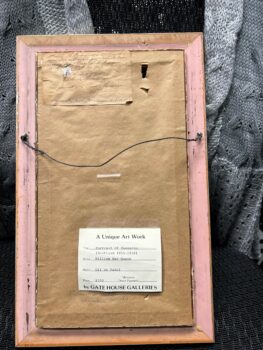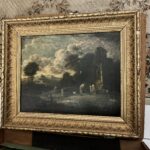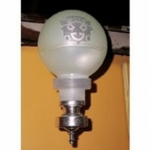This art appraisal report offers an in-depth and impartial assessment of the artwork in question, grounded in the appraiser’s expertise and familiarity with the art market. All the information and data analyzed in this report is sourced solely from the client.
Having a clear understanding of the value of your artwork is crucial in making informed decisions about its future. This report provides a precise estimate of the value of each piece, using US dollars as the base currency. It is not intended to encourage the sale of the artwork, but rather to provide valuable information on how to proceed should the client decide to do so in the future.
Detailed description of the artwork, including its medium, dimensions, and condition.
Checking Originality: Identification with Artificial Intelligence Test
In the quest to identify a match, Image Search employs advanced AI techniques to scour databases of images in order to find visually similar images. This is achieved through the use of various algorithms such as pattern recognition and machine learning. While some results may be considered as “matches” due to a clear similarity, other results may be inconclusive as they rely more on chance rather than any specific similarities. To conduct this test, a front-facing image was used as a reference to search for similar images on the internet.
The results of the automatic recognition are not conclusive. If a match is found, it will be shown below:
What specific information can we obtain from this test?
Our findings demonstrate this is a unique work of art; the comparison images in our gallery could not be matched with it. Even though there is always some uncertainty, we’ve found that this method gives accurate results 90% of the time, so it’s a good way to start figuring out if something is real. To completely identify the artwork, I continue to the next test.
These results show clear similarities in scene, style, and/or colors. We can’t draw a conclusion yet because this coincidence could be caused by a lot of different things, like an artist with a certain style, a copy, a limited edition print, or a regular print. I need to keep going through the research and inspection steps to get to the final conclusion.
The algorithm found an exact match. This result is associated with prints, either regular or limited edition prints, that were hand signed by the original artist of this piece of art. It’s important to determine what type you have, so I need to go through the research and inspection process.
Age estimation
Age can be determined by many factors when it comes to a painting. In the case of the Salvador Dali painting, there are a few characteristics that can be used to determine its age. For example, the frame construction can give insight into the painting's age. If the frame is ornate and gilded, it is likely that the painting is from the Baroque period. If the frame is more simplistic and modern, it could be from the 20th century. Additionally, the color palette used can also provide clues to the painting's age. If the colors are muted and earthy, the painting is likely from the Renaissance period. If the colors are bright and vivid, the painting is likely from the Impressionist period. Finally, if the painting contains elements of surrealism, then the painting can be assumed to be from the Surrealist period. Therefore, examining the frame construction, the color palette, and the style of the painting can help to determine the age of a Salvador Dali painting.
Based on this information and the pictures provided, I can estimate this painting was made
Condition of the artwork
This Salvador Dali painting is in excellent condition, with no signs of restoration needed. There is no appreciable damage to the painting, and if there is any damage present, it is very minimal. This painting is a great example of a masterful painting in excellent condition, and it is an asset to any collection.
Artist’s name, biographical information, artwork’s provenance (history of ownership) and exhibition history.
I study and research the signature of artwork to see if it matches any known signatures. At this step, I also inspect the painting’s front and back pictures, to find an artist’s name or other identifying features like stickers that may help me identify who has made this work. If there is any, provenance is also seen as an important variable because it helps figure out who the artist is.

A close picture of the signature is included in this report.
I can read the signature as:
At this point, I can use the signature and try to find the artist’s name in a database of known-listed artists. Basically, it is a database with information about the names, surnames, origins, and biographies of the most well-known artists.
I found that the artist who painted this artwork is a
Detailed analysis of the artwork’s style, subject matter, and significance within the artist’s oeuvre and the broader art world.
I can check if the style and type of painting match those of the artist referenced.
The artistic style of a painting by Salvador Dali is often characterized by its surrealism, fantastic dreamscapes, and imaginative symbolism. He often employed a unique blend of classical and modern elements, incorporating a wide range of influences from Renaissance masters to Freudian psychoanalysis. His paintings often contained distorted human figures and landscapes, as well as unexpected juxtapositions and optical illusions. Dali's art is highly distinctive and instantly recognizable, making it an iconic representation of the Surrealist movement.
Comparable sales information, including prices realized at recent auctions or private sales of similar works by the artist or in the same medium.
In order to provide an up-to-date estimate of the fair market value for the Salvador Dali painting, I utilized the data collected, including auction prices and other relevant market information. This is crucial as it can be used in various contexts such as insurance, estate planning, and art market analysis, with an emphasis on the historical significance of this particular artist. It also offers a valuable insight into how the valuation of the artwork may have changed due to environmental or economic factors, specifically the rise of the Spanish surrealist movement.
The auction prices were a significant factor in determining the current market value of the artwork, as they are based on actual transactions between buyers and sellers in the art market. As such, they are a strong indicator of the expected value of the piece in the near future.
By analyzing auction results from the last 6 months, I was able to accurately determine the current fair market value of the artwork. This approach provides a comprehensive view of how the value has changed over time and gives insight into any potential areas of appreciation or depreciation in its price. Additionally, it allows me to adjust my valuation as new auction prices become available.
Conclusion
Investing in art can be a great idea for many reasons. Art is incredibly diverse and allows you to express yourself and show off your style. Not to mention, it can also be an excellent investment. Art can increase in value over time, so purchasing a piece of artwork can be a great way to diversify your portfolio and add a unique touch to any space. Additionally, art can be a great conversation starter and provide a unique talking point when entertaining guests. With so many different styles and genres to choose from, it’s easy to find something that appeals to you, and if you do your research, you can find pieces that can potentially make you some money in the long run.
Salvador Dali is a very famous and highly regarded artist, and his paintings are considered valuable by the art market because of their rarity and the high demand for them. As a result, his paintings can fetch very high prices, even if they are not particularly well-known pieces. This is because of his status as one of the most important painters of the 20th century and the recognition of his iconic style. His paintings are also seen as a sign of wealth and distinction, and are often kept as investments by collectors.
Final Appraisal Value ($)
$
Appraisal Report made by:
Andrés Gómez
BSc, MSc, Expert Art Appraiser
10+ years of experience in Online Art Appraisals
100k+ Customers Served
Antique Store Owner
You can check my portofolio of past appraisals here:
https://www.appraisily.com/andres-portofolio/

Relevant photographs or supporting documentation, such as condition reports or expert opinions
A detailed summary of the appraisal process and the appraiser’s qualifications.
Mark-to-market art appraisal is a vital method for determining the current value of a piece of artwork. This form of valuation requires an appraiser to consider various factors, such as market conditions, the condition and age of the artwork, and the artist’s reputation. By taking all these elements into account, a mark-to-market art appraisal delivers an accurate assessment of a piece of artwork’s current market value.
The artist’s reputation, as determined by their track record in gallery and museum shows, awards, and other accomplishments, is also considered in mark-to-market art appraisal. Appraisers use this information to determine if the value of a piece is likely to increase or decrease over time. Additionally, they will inspect the condition of the artwork and note any signs of wear or damage that might affect its future resale value.
When performing mark-to-market art appraisals, appraisers also consider market conditions by researching current art market trends and comparable works that have recently sold. This information is used to provide an estimate of a piece’s worth at that point in time. By considering all of these factors, mark-to-market art appraisal is able to give a reliable indication of the current value of a work. This kind of valuation can also ensure fair prices are paid and received when buying or selling art.
In summary, mark-to-market art appraisal is a crucial tool for determining the true value of a piece of artwork, enabling buyers, sellers, and appraisers to make informed decisions regarding its worth. It takes into account multiple aspects to provide an accurate assessment of the current market value of a work. This information can be used to ensure that buyers and sellers are getting a fair price for the artwork, and that the appraiser’s valuation is up-to-date and reflective of current market conditions.
In the case of insurance replacement appraisals, mark-to-market art appraisals can also be used to accurately estimate the cost of replacing a lost or damaged artwork. The current value, as determined by the appraisal, is then used to determine the amount that the insurance company will pay back to the policyholder. This way, policyholders can rest assured that they will receive an appropriate sum for any artwork that needs to be replaced due to accidental damage or theft. Additionally, this kind of valuation helps insurers ensure they are not being overcharged when artwork needs to be replaced as part of a claim settlement.
The appraisal process is a thorough evaluation of the item or items in question. It involves researching and analyzing the information provided by the requester in order to provide an accurate estimate of its value. The appraiser takes into account factors such as condition, rarity, demand, and market prices. Photographs and detailed descriptions are especially important when providing an appraisal, since they help the appraiser identify any potential flaws or defects that could affect the item’s worth. By using all the resources that are available, an evaluation can be done quickly, efficiently, and with a high level of accuracy.
A statement of the appraiser’s liability and any potential conflicts of interest.
A qualified art appraisal, also known as a formal written evaluation, is a professional assessment of the monetary value of a piece of art by an individual who has specialized knowledge, expertise, and training in the field of art appraisal. This person must meet certain educational and professional requirements, including experience in researching and evaluating art, as well as knowledge of the art market and current market trends. The purpose of a qualified art appraisal is to provide an objective and unbiased opinion of the value of a piece of art for various purposes, including insurance claims, tax planning, estate planning, or to help determine a fair price for a sale or purchase.
We are committed to providing our clients with the most accurate and unbiased appraisal reports. To ensure impartiality, we adopt a flat rate, fixed fee structure for all appraisals, instead of a percentage-based fee. This eliminates any potential conflicts of interest between the art appraiser and the final report value. Our appraisal reports are in compliance with the Appraisal Foundation’s USPAP (Uniform Standards of Professional Appraisal Practice) standards and guidelines, which are widely accepted as the ethical and performance standards for appraisers. This guarantees that our reports are of high quality and legally defensible.
How to sell this artwork.
We have a structured guide to help you sell your artwork, you can find it here.






You could definitely see your expertise in the work you write. The world hopes for even more passionate writers like you who aren’t afraid to say how they believe. Always go after your heart.
Muchos Gracias for your article post. Much obliged.
A motivating discussion is definitely worth comment. I believe that you ought to write more on this subject matter, it might not be a taboo matter but usually folks don’t discuss these topics. To the next! All the best!!